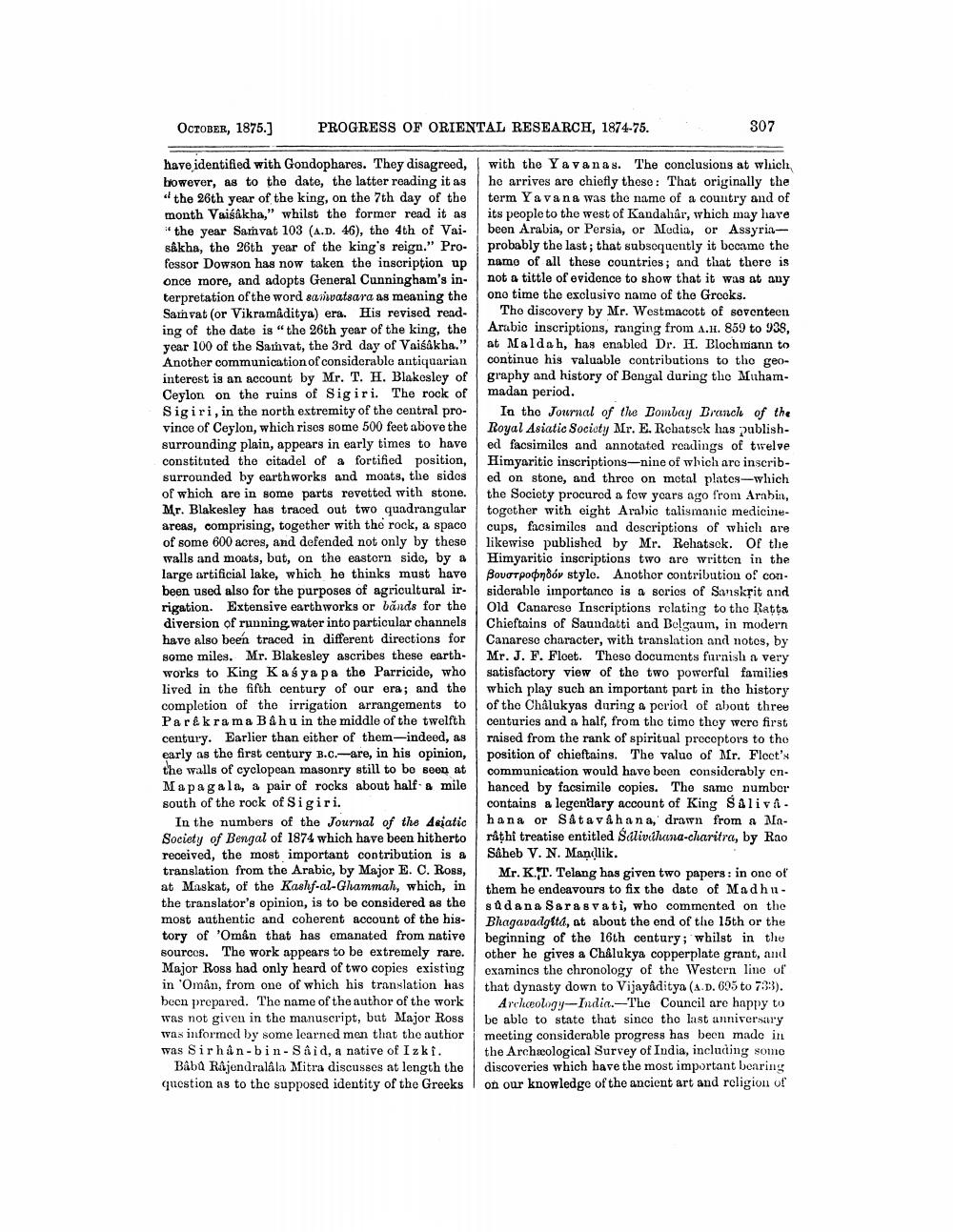________________
OCTOBER, 1875.]
have identified with Gondophares. They disagreed, however, as to the date, the latter reading it as the 26th year of the king, on the 7th day of the month Vaisakha," whilst the former read it as the year Samvat 103 (A.D. 46), the 4th of Vaisâkha, the 26th year of the king's reign." Professor Dowson has now taken the inscription up once more, and adopts General Cunningham's interpretation of the word samvatsara as meaning the Samvat (or Vikramâditya) era. His revised reading of the date is "the 26th year of the king, the year 100 of the Samvat, the 3rd day of Vaisakha." Another communication of considerable antiquarian interest is an account by Mr. T. H. Blakesley of Ceylon on the ruins of Sigiri. The rock of Sigiri, in the north extremity of the central province of Ceylon, which rises some 500 feet above the surrounding plain, appears in early times to have constituted the citadel of a fortified position, surrounded by earthworks and moats, the sides of which are in some parts revetted with stone. Mr. Blakesley has traced out two quadrangular areas, comprising, together with the rock, a spaco of some 600 acres, and defended not only by these. walls and moats, but, on the eastern side, by a large artificial lake, which he thinks must have been used also for the purposes of agricultural irrigation. Extensive earthworks or bands for the diversion of running water into particular channels have also been traced in different directions for some miles. Mr. Blakesley ascribes these earthworks to King Kasyapa the Parricide, who lived in the fifth century of our era; and the completion of the irrigation arrangements to Parakrama Bahu in the middle of the twelfth century. Earlier than either of them-indeed, as early as the first century B.C.-are, in his opinion, the walls of cyclopean masonry still to be seen at Mapagala, a pair of rocks about half a mile south of the rock of Sigiri.
PROGRESS OF ORIENTAL RESEARCH, 1874-75.
In the numbers of the Journal of the Asiatic Society of Bengal of 1874 which have been hitherto received, the most important contribution is a translation from the Arabic, by Major E. C. Ross, at Maskat, of the Kashf-al-Ghammah, which, in the translator's opinion, is to be considered as the most authentic and coherent account of the history of 'Omân that has emanated from native sources. The work appears to be extremely rare. Major Ross had only heard of two copies existing in 'Omân, from one of which his translation has been prepared. The name of the author of the work was not given in the manuscript, but Major Ross was informed by some learned men that the author was Sirhân-bin- Sâid, a native of Izki.
Bâbû Rajendralâla Mitra discusses at length the question as to the supposed identity of the Greeks
307
with the Yavanas. The conclusions at which he arrives are chiefly these: That originally the term Yavana was the name of a country and of its people to the west of Kandahar, which may have been Arabia, or Persia, or Media, or Assyriaprobably the last; that subsequently it became the name of all these countries; and that there is not a tittle of evidence to show that it was at any one time the exclusivo name of the Greeks.
The discovery by Mr. Westmacott of seventeen Arabic inscriptions, ranging from A.H. 859 to 938, at Maldah, has enabled Dr. H. Blochmann to continue his valuable contributions to the geography and history of Bengal during the Muhammadan period.
In the Journal of the Bombay Branch of the Royal Asiatic Society Mr. E. Rchatsek has published facsimiles and annotated readings of twelve Himyaritic inscriptions-nine of which are inscribed on stone, and three on metal plates-which the Society procured a few years ago from Arabin, together with eight Arabic talismanic medicinecups, facsimiles and descriptions of which are likewise published by Mr. Rehatsck. Of the Himyaritic inscriptions two are written in the Bourpopnoór style. Another contribution of considerable importance is a series of Sanskrit and Old Canarese Inscriptions relating to the Ratta Chieftains of Saundatti and Belgaum, in modern Canarese character, with translation and notes, by Mr. J. F. Floet. These documents furnish a very satisfactory view of the two powerful families which play such an important part in the history of the Chalukyas during a period of about three centuries and a half, from the time they were first raised from the rank of spiritual preceptors to the position of chieftains. The value of Mr. Fleet's communication would have been considerably enhanced by facsimile copies. The same number contains a legendary account of King Salivahana or Satavahana, drawn from a Marâthi treatise entitled Salivahana-charitra, by Rao
Saheb V. N. Mandlik.
Mr. K.T. Telang has given two papers: in one of them he endeavours to fix the date of Madhusûdana Sarasvati, who commented on the Bhagavadgitá, at about the end of the 15th or the beginning of the 16th century; whilst in the other he gives a Chalukya copperplate grant, and examines the chronology of the Western line of that dynasty down to Vijayâditya (A.D. 695 to 733).
Archaeology-India. The Council are happy to be able to state that since the last anniversary meeting considerable progress has been made in the Archæological Survey of India, including some discoveries which have the most important bearing on our knowledge of the ancient art and religion of




